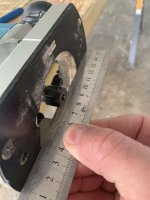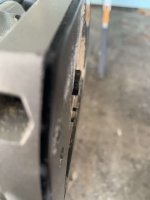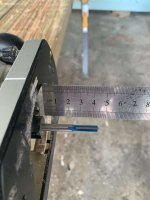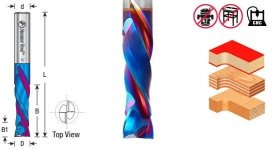I'm considering this router for a specific requirement, but I would like to get an idea of the plunge depth. Essentially, how far down can you make the plunge before the router bottoms out. Will it plunge all the way until the collet hits the wood? Does the clear plastic dust hood obstruct the collet/machine? I have a need to make a very deep cut and my current router will bottom out with about 1/2" between the collect and the wood surface.
You are using an out of date browser. It may not display this or other websites correctly.
You should upgrade or use an alternative browser.
You should upgrade or use an alternative browser.
OF1010 Router plunge depth question
- Thread starter Aux2496
- Start date
woodbutcherbower
Member
- Joined
- Apr 25, 2021
- Messages
- 1,217
I’m sure an OF1010 owner will be along to chime in any time soon - but if the machine won't actually do what you need, FYI my little quarter-inch Makita (RP1100C) will do this;
[attachimg=1]
[attachimg=2]
You’ll need to temporarily remove one of the screws on the rotary plunge depth stop, but it does what you need. What depth of cut do you need to make? The deepest I can go with a regular extended-shaft 2-flute is 45mm = just over an inch and three-quarters. Take it slow, 4 or 5 passes of no more than 10mm at a time. You’ll need to remove the clear plastic dust shroud (10 seconds on this particular machine) - but to be honest, you’re never going to achieve flawless dust control going this deep because the trench just fills up with routed-out debris. Just make a mess and then clean it up [big grin]
[attachimg=3]
Kevin
[attachimg=1]
[attachimg=2]
You’ll need to temporarily remove one of the screws on the rotary plunge depth stop, but it does what you need. What depth of cut do you need to make? The deepest I can go with a regular extended-shaft 2-flute is 45mm = just over an inch and three-quarters. Take it slow, 4 or 5 passes of no more than 10mm at a time. You’ll need to remove the clear plastic dust shroud (10 seconds on this particular machine) - but to be honest, you’re never going to achieve flawless dust control going this deep because the trench just fills up with routed-out debris. Just make a mess and then clean it up [big grin]
[attachimg=3]
Kevin
Attachments
I have one of the new OF1010's.
Looks like the collet can protrude 2.3mm past the base surface.
I could not measure perfectly because I have it set up right now for some cuts and can't change anything.
In a pinch, might be able to get a touch more by removing the stop screw or stop wheel.
Looks like the collet can protrude 2.3mm past the base surface.
I could not measure perfectly because I have it set up right now for some cuts and can't change anything.
In a pinch, might be able to get a touch more by removing the stop screw or stop wheel.
Thanks guys. I don't need it the collet to plunge past the base of the router. The cuts I need to make are round holes through 1-1/2" of plywood using a 3/4" pattern jig. So the bit has to extend 2-1/2" past the base of the router. There will be ample space for generating chips and dust collection.
Michael Kellough
Member
- Joined
- Jan 23, 2007
- Messages
- 7,096
You know the OF 1100 does not take 1/2” shank bits?
Better find the bit first…
Better find the bit first…
woodbutcherbower
Member
- Joined
- Apr 25, 2021
- Messages
- 1,217
Michael Kellough said:You know the OF 1100 does not take 1/2” shank bits?
Better find the bit first…
[member=77955]Aux2496[/member] what Michael correctly said above. No-one produces either a quarter-inch or 8mm router bit of that length - it's just not safe or feasible without the risk of the shaft fracturing. The pic I showed above (45mm plunge) is right on the absolute limit of what a quarter-inch shaft will take. I fortunately only have to use that setup once in a blue moon - and it worries me every time I do. Any deeper - a half-inch machine is the only way to do it.
EDIT - I'm in the UK so I just checked the Trend cutter catalogue. 63mm (2.5") is the longest cutter they produce - and as expected, it's a half-inch shaft. The 45mm quarter-inch version pictured above has been discontinued, and I can guess why. You remember that scene in 'Jaws' where the guys says "We're going to need a bigger boat" ?
https://www.trend-uk.com/c164x1-2tc-two-flute-cutter-12-7mm-diameter
What diameter are your holes going to be?
Michael Kellough
Member
- Joined
- Jan 23, 2007
- Messages
- 7,096
Just switch to a 1/4” pattern. There are plenty 1-1/4” top bearing bits.
Michael Kellough
Member
- Joined
- Jan 23, 2007
- Messages
- 7,096
This is a super nice bit for the purpose but you’d need to use a template bushing. since it doesn’t have a bearing.
1-1/4” cutter height top and bottom bearing bits.
1-1/4” cutter height top and bottom bearing bits.
Cheese
Member
- Joined
- Jan 16, 2015
- Messages
- 12,505
Michael Kellough said:
I wonder why they don't recommend using this in a router or router table?
[attachimg=1]
Attachments
Michael Kellough
Member
- Joined
- Jan 23, 2007
- Messages
- 7,096
I didn't notice that Cheese. I'm guessing just because it's solid carbide.
Crazyraceguy
Member
- Joined
- Oct 16, 2015
- Messages
- 4,901
Cheese said:Michael Kellough said:
I wonder why they don't recommend using this in a router or router table?
[attachimg=1]
With big panel raising bits it's obvious, but in this case not so much.
I would guess that it's because, in general you use a compression bit to cut out parts, looking for a good surface finish on both sides. This is not typical of hand held routing. On a CNC machine, there is at least some attempt at controlling the parts as they are cut loose, or they are retained by tabs, again not typical of hand held routing.
If you cut too shallow on the first pass, a compression bit acts like an up-cut, maybe giving you some tear-out on top. There is no real reason you can't though. I use a 1/2" compression bit quite often at work.
woodbutcherbower said:Michael Kellough said:You know the OF 1100 does not take 1/2” shank bits?
Better find the bit first…
[member=77955]Aux2496[/member] what Michael correctly said above. No-one produces either a quarter-inch or 8mm router bit of that length - it's just not safe or feasible without the risk of the shaft fracturing. The pic I showed above (45mm plunge) is right on the absolute limit of what a quarter-inch shaft will take. I fortunately only have to use that setup once in a blue moon - and it worries me every time I do. Any deeper - a half-inch machine is the only way to do it.
EDIT - I'm in the UK so I just checked the Trend cutter catalogue. 63mm (2.5") is the longest cutter they produce - and as expected, it's a half-inch shaft. The 45mm quarter-inch version pictured above has been discontinued, and I can guess why. You remember that scene in 'Jaws' where the guys says "We're going to need a bigger boat" ?
https://www.trend-uk.com/c164x1-2tc-two-flute-cutter-12-7mm-diameter
What diameter are your holes going to be?
CMT 174.121.11; D=12mm, cutting edge = 40mm long, has top-cut too, total length = 90mm. Shaft is 8mm
Also available in same length with in diameters 8, 10, 12, 14, 16, 20, 22, 24
I don't do anything with 1/4" or 1/2"; everything I have is 8mm or 12mm shaft. I don't even own any collets in other sizes.
Cheese
Member
- Joined
- Jan 16, 2015
- Messages
- 12,505
Crazyraceguy said:With big panel raising bits it's obvious, but in this case not so much.
I would guess that it's because, in general you use a compression bit to cut out parts, looking for a good surface finish on both sides. This is not typical of hand held routing. On a CNC machine, there is at least some attempt at controlling the parts as they are cut loose, or they are retained by tabs, again not typical of hand held routing.
If you cut too shallow on the first pass, a compression bit acts like an up-cut, maybe giving you some tear-out on top. There is no real reason you can't though. I use a 1/2" compression bit quite often at work.
[attachimg=1]
Well, I was curious so I emailed Toolstoday and asked them for their input, the results:
Q: Why do you recommend this bit not be used in a router or router table?
A: CNC Router Bits are special bits that take advantage of the special capabilities of CNC Routers and the particular material and work style situations they are used with which cannot be achieved with a handheld or router table.
Q: Would there be any harm if I used this in a router or router table?
A: It is not recommended but it will work. You just wont get the same results as if it was used on a CNC machine.
[blink] Well that certainly cleared things up. [blink]
Also worth noting, the Amana solid carbide, 2-flute, compression, 1/2" shank x 1.5" cut length bit is $117 while the same bit from Woodpeckers is $70.
Attachments
Thanks for the replies. I was not realizing that the OF1010 is limited to 1/4" bits. Long story short, I was able to get my current router to plunge all the way by removing a plastic piece in the middle. This is the bit I got and I will give it a go:
Amana Tool - 47228 Carbide Tipped Flush Trim Plunge Template 1/2 Dia x 1-1/4 x 1/2" Sh
It's 3-1/2" long, so I should, hopefully, be able to succeed in a very deep plunge.
Amana Tool - 47228 Carbide Tipped Flush Trim Plunge Template 1/2 Dia x 1-1/4 x 1/2" Sh
It's 3-1/2" long, so I should, hopefully, be able to succeed in a very deep plunge.
Michael Kellough
Member
- Joined
- Jan 23, 2007
- Messages
- 7,096
Aux2496 said:Thanks for the replies. I was not realizing that the OF1010 is limited to 1/4" bits. Long story short, I was able to get my current router to plunge all the way by removing a plastic piece in the middle. This is the bit I got and I will give it a go:
Amana Tool - 47228 Carbide Tipped Flush Trim Plunge Template 1/2 Dia x 1-1/4 x 1/2" Sh
It's 3-1/2" long, so I should, hopefully, be able to succeed in a very deep plunge.
The OF1100 takes 8mm and 1/4” bits.
That Amana bit is interesting but the cutter length is still only 1-1/4” and the shank is undercut to the point that it’s not very different from a 1/4” bit. Also, how is the bearing installed?
Cheese
Member
- Joined
- Jan 16, 2015
- Messages
- 12,505
Michael Kellough said:That Amana bit is interesting but the cutter length is still only 1-1/4” and the shank is undercut to the point that it’s not very different from a 1/4” bit. Also, how is the bearing installed?
An interesting looking bit indeed. [blink] Amana does offer replacement bearings.
[attachimg=1]
Attachments
Aux2496 said:Thanks for the replies. I was not realizing that the OF1010 is limited to 1/4" bits. Long story short, I was able to get my current router to plunge all the way by removing a plastic piece in the middle. This is the bit I got and I will give it a go:
Amana Tool - 47228 Carbide Tipped Flush Trim Plunge Template 1/2 Dia x 1-1/4 x 1/2" Sh
It's 3-1/2" long, so I should, hopefully, be able to succeed in a very deep plunge.
Huh, so you had a router with 1/2" collet all along that could just do the job?
Either way; the OF-1010 isn't limited to 1/4". It takes 8mm
Michael Kellough said:The OF1100 takes 8mm and 1/4” bits.
That Amana bit is interesting but the cutter length is still only 1-1/4” and the shank is undercut to the point that it’s not very different from a 1/4” bit. Also, how is the bearing installed?
Yeah, I know. Basically, my point is that the OF1010 would not take a 1/2" bit.
The undercut portion is not so small. It's actually just a hair under 3/8" -- 9mm to be exact. I have no idea how the bearing is installed.
Anyways, the bit worked great! I was able to plunge through 1-1/2" of material with absolutely no problem in addition to the 3/4" pattern board on top. That's a total depth of 2-1/4" past the bottom of the router! I had to do it in two steps - did an initial depth plunge to cut the pattern and the a through-material plunge to cut away the remaining material.
Cheese said:Michael Kellough said:That Amana bit is interesting but the cutter length is still only 1-1/4” and the shank is undercut to the point that it’s not very different from a 1/4” bit. Also, how is the bearing installed?
An interesting looking bit indeed. [blink] Amana does offer replacement bearings.
[attachimg=1]
Is one part screwed in the other, hence the flat sides?? Now that you say it... I realize why the 'bearing on top' flus-cut bits are so big; bearing needs to to fit over the shaft.
Similar threads
- Replies
- 54
- Views
- 5K






